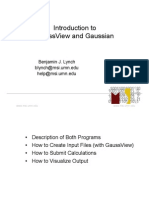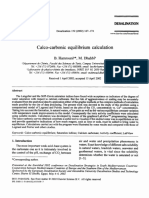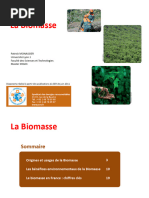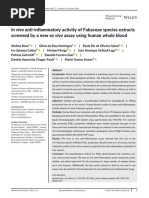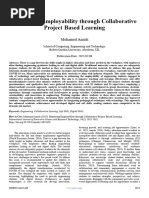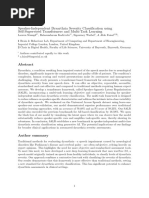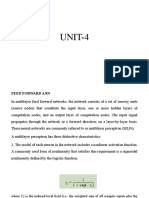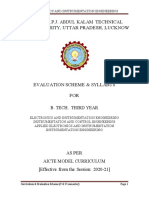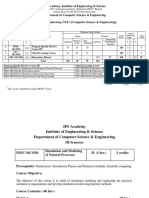Prediction of Performance Efficiency For Wastewater Treatment Plant's Effluent Biochemical Oxygen Demand Using Artificial Neural Network
Prediction of Performance Efficiency For Wastewater Treatment Plant's Effluent Biochemical Oxygen Demand Using Artificial Neural Network
Copyright:
Available Formats
Prediction of Performance Efficiency For Wastewater Treatment Plant's Effluent Biochemical Oxygen Demand Using Artificial Neural Network
Prediction of Performance Efficiency For Wastewater Treatment Plant's Effluent Biochemical Oxygen Demand Using Artificial Neural Network
Original Description:
Original Title
Copyright
Available Formats
Share this document
Did you find this document useful?
Is this content inappropriate?
Copyright:
Available Formats
Prediction of Performance Efficiency For Wastewater Treatment Plant's Effluent Biochemical Oxygen Demand Using Artificial Neural Network
Prediction of Performance Efficiency For Wastewater Treatment Plant's Effluent Biochemical Oxygen Demand Using Artificial Neural Network
Copyright:
Available Formats
Volume 8, Issue 1, January – 2023 International Journal of Innovative Science and Research Technology
ISSN No:-2456-2165
Prediction of Performance Efficiency for Wastewater
Treatment Plant’s Effluent Biochemical Oxygen
Demand Using Artificial Neural Network
Samson Balogun Toochukwu Chibueze Ogwueleka
Department of Civil Engineering, Faculty of Engineering, Department of Civil Engineering, Faculty of Engineering,
University of Abuja P.M.B 117, Abuja Nigeria. University of Abuja P.M.B 117, Abuja Nigeria.
Abstract:- This study investigated the application of an Wastewater treatment plants (WWTPs) are built to clean
artificial neural network (ANN) to predict the wastewater and convert it into eco-friendlier water which is
performance efficiency of the Abuja-based Wupa WWTP, released into the environment (Varkeshi et al., 2019).
Nigeria using effluent 5-day biochemical oxygen demand However, due to the wide fluctuation in the quality and
(BOD5) as a performance indicator. Daily data of influent quantity of untreated wastewater transported to the treatment
BOD5, pH, total dissolved solids, total suspended solids, plant, the operation of WWTPs can be difficult and
chemical oxygen demand, total coliform, Escherichia challenging (Szeląg et al. 2017).
coliform, and fecal coliform; and effluent BOD5 over a
period of five years (2013 to 2017) for the Wupa WWTP Moreover, many treatment plants are constructed
was utilized for the plant’s performance efficiency. The following the conventional activated sludge system which is
four most reliable multilayer perceptron ANN (MLP- allegedly riddled with inefficiencies associated with pollutant
ANN) algorithms namely, Levenberg-Marquardt (LM) removal (Ogwueleka and Samson, 2020). In addressing the
backpropagation resilient backpropagation, Quasi- challenges of the conventional treatment systems, several
Newton backpropagation, and Fletcher-Reeves conjugate alternative methods have been proposed, notable amongst
gradient backpropagation were adopted; and the most which are the advanced oxidation processes (AOPs) (Deng
appropriate model was selected following training, and Zhao, 2015); nanomaterials (Adeleye et al., 2016);
validation and testing by altering the number of neurons microalgae-activated sludge (MAAS) (Ogwueleka and
and activation functions in both the hidden and output Samson, 2020); microbial electrochemical system (Li et al.,
layers. The model efficiency was determined using mean 2021). However, many of these emerging methods are still
square error (MSE) and correlation coefficient (R2). The limited to pilot or laboratory scales and are yet to gain
ML algorithm with Logsig-Tansig activation pairing and widespread practical applications due to a number of reasons
architecture [8-1270-1] performed the best in terms of such as the initial cost of installation, uncertainties with
convergence time and prediction error, with MSE and R 2 operations, adaptation and installation of new technologies,
values of 1.522 and 0.922, respectively. Also, it revealed etc.; thus, there is still need to seek for means of attaining
that the selected ANN model predicted the effluent BOD 5 efficiency, even in the pre-existing installed treatment
with an overall correlation coefficient of 0.962; thus, systems; which can be achieved by attaining and maintaining
demonstrating the efficacy of ANN models for accurate optimal conditions in WWTPs.
prediction of the Wupa WWTP performance. The novelty
of this research is in evaluating the efficiency of the plant Attaining optimal operational conditions in WWTPs
over the periods and determining the most precise ANN even with conventional systems is possible and can be
model for Wupa WWTP, Abuja, Nigerians a study which achieved with the use of models to predict the WWTP
has never been carried out before now. performance based on previous measurements of major plant
parameters (Jami et al., 2012).
Keywords:- Artificial Neural Network (ANN); Wastewater
Treatment Plant (WWTP); 5-Day Biochemical Oxygen An important parameter commonly utilized to examine
Demand (BOD5); Wupa WWTP; Multilayer Perceptron the performance of WWTPs is the 5-day biochemical oxygen
(MLP) demand (BOD5) (Dogan et al. 2008; Araromi et al., 2018).
BOD5 is an approximation of the quantity of biochemically
I. INTRODUCTION degradable organic matter contained in a water sample,
defined as the amount of oxygen necessary for the aerobic
The treatment and management of wastewater in our bacteria present in a sample to oxidize the organic matter to a
environment have increasingly gained attractive attention in stable organic form (Dogan et al., 2008). It is, however,
the last decade, particularly in the face of the incessantly difficult to measure, and requires five days for its
increasing volume of wastewater owing to population growth; determination (Dogan et al., 2008; Alsulaili and Refaie, 2021).
rapid urbanization; increased agricultural; and industrial Therefore, the determination of the output BOD5 of a WWTP
activities (Abba and Elkiran 2017; Arismendy et al., 2020; as a performance index using predictive tools could achieve
Alsulaili and Refaie, 2021).
IJISRT23JAN1267 www.ijisrt.com 1991
Volume 8, Issue 1, January – 2023 International Journal of Innovative Science and Research Technology
ISSN No:-2456-2165
safe and economic treatment process management (Araromi et Alsulaili and Refaie (2021) investigated the use of ANN
al., 2018; Varkeshi et al., 2019). in predicting BOD5 in the WWTP, Kuwait, using seven years
of data dating from 2013 to 2019; the outcome of the study
Several models have been employed for the prediction of indicated that the applied model for the BOD5 prediction
a variety of WWTP performance indicators; among them, achieved a high level of precision with an R2 value of 0.754,
artificial neural network (ANN) has risen in popularity and has implying the viability of the model. Saleh (2021) applied
proven to be excellent in terms of the following advantages ANN models to predict BOD5, total suspended solids (TSS),
Ability to model complex functions with high precision and chemical oxygen demand (COD) in the effluent of the
Modelling of multiple inputs and output concurrently Muamirah WWTP, Al-Hillah using a two years dataset. The
It can accommodate workings with noisy and missing result of the study indicated the capability of ANN for COD,
parametric BOD5, and TSS modeling.
It can train and update the model with dated data
II. ARTIFICIAL NEURAL NETWORK
In spite of the outlined advantages amongst others, there
are also some pitfalls with the workings and the development An artificial neural network is an aspect of artificial
of the ANN model intelligence that mimics the operation of the human central
There is no physical significance of model parameters nervous system in receiving and computing information
Underfitting and overfitting may sometimes result due to a systems. it is based on a system of interconnected “neurons”
lack of standards in the determination of the network forming the basis of neural network operation (Alsulaili and
architecture (trial and error methods are used) Refaie, 2021; Setshedi et al., 2021; Saleh, 2021). The model
uses a network system similar to the human brain called
ANN model is primarily computer dependent due to the
neurons, to learn and predict various parameters. ANN is
enormous data needed to train the neurons.
gaining quick popularity in the area of artificial intelligence
and machine learning due to its robustness and precision
In the last two decades, studies conducted on the
accuracy. The significance of ANN is to determine the
modeling and prediction ability of the NN model. ANN was
computational relationship between the dependent and the
used to estimate wastewater treatment plant inlet biochemical
dependent variable especially due to the anthropogenic nature
oxygen demand. The results obtained show its flexibility,
simplicity, the accuracy of prediction, and robust structure of the wastewater variable. The relationship is established by
designing a network architecture in which previous
(Dogan et al., 2008; Banaei et al., 2013; Bekkari and Zeddouri,
information(data) is used to train the network during the
2018; Abba et al., 2020; Alsulaili and Refaie 2021; Setshedi et
learning phase to build models Figure l.
al. 2021). ANN was used for the modeling of wastewater
treatment and desalination using membrane processes, At the
There are many types of ANN depending on their
end of the study ANN shows high capability in terms of both
accuracy and short time of computation compared to the peculiarity in terms of architecture and parameters. the
commonly used is backpropagation a feed-forward neural
conventional method (Jasir et al., 2021).
network that could be called multilayer perceptron (PLP). we
have other types of ANN used for computational analysis such
A variety of notable studies such as (Ogwueleka and
as; Radial Basial Function Neural Networks (RBFN)
Ogwueleka, 2009; Ogwueleka and Ogwueleka 2010; Vyas et
Networks current Neural Networks (RNN), Elman, Neural
al., 2011; Jami et al. ,2012; Banaei et al., 2013; Ahmadzadeh
Network Networks Deep Neural Networks (DNN) are some of
et al. 2015; Xue 2017; Bekkari and Zeddouri, 2018; Katip
the typologies of MLP-ANN with different training algorithms
2018; Arismendy et al., 2020; Gawdzik et al., 2020; Alsulaili
and model architecture.
and Refaie, 2021; Saleh, 2021; Saleh and Kayi, 2021) have
documented the application of ANN to model various
A. Multi-layer Perceptron
hydrology and environmental engineering issues. A
remarkable application among these studies is the application MLP type which this study is set-out to apply consist of
the impute layer, one or more hidden layers, and an output. at
of ANN to model and predict BOD in diverse WWTPs across
each layer, the numbers of neurons at each layer are equal to
the globe.
the number of variables at both input and output in the
architecture. do, at the hidden layer there could be a greater
number of neurons irrespective of the input or the output
layers. The quality of the computation ability at the hidden and
the output layers is a function of the quantum of the calculated
data assigned to the neurons called weights. A typical ANN
MLP architecture is shown in the schematic diagram below:
IJISRT23JAN1267 www.ijisrt.com 1992
Volume 8, Issue 1, January – 2023 International Journal of Innovative Science and Research Technology
ISSN No:-2456-2165
(log-sigmoid), hyperbolic tangent sigmoid (tan-sigmoid), and
linear transfer functions (purelin), whose output ranges and
equations are given in Eq. (2).
B. Significance of the study
Vyas et al. (2011) studied the relevance of ANN
techniques to predict influent and effluent BOD5 for WWTP
in Govindpura, Bhopal; using 3 years of data and two ANN
models. The result for model 1 and model 2 showed R values
of 0.9 and 0.73 respectively; which is an indication that ANN
provides highly acceptable outcomes. Rene and Saidutta
(2008) employed 12 AANN-based models to predict BOD5
and COD levels in wastewater generated from the treatment
plant of a petrochemical industry in Mangalore, India. The
results revealed that; through its diverse training procedure,
Fig.1. A typical schematic single hidden layer MLP ANNs can accurately and effectively predict concentrations of
architecture of (4-4-2) water quality indicators.
III. PREPARE YOUR PAPER BEFORE STYLING Dogan (2008) established an ANN model to predict BOD
in the inlet of WWTPs, and the results demonstrated that the
However, there are basically three phases of developing ANN may be used to accurately estimate daily BOD at the
an ANN model: training, validation, and prediction. During input of wastewater treatment facilities. Hamed et al. (2004)
this process, the data set is divided into three groups, usually developed two ANN models to forecast the effluent
for the purpose of this study and other development studies concentrations of BOD and suspended solids for a major
reported. the data set is divided into a ratio of 70:15:15 WWTP in Cairo; using a 10 months dataset. The study
presents.70% of the data set is usually assigned to the training reported that the prediction error fluctuated minimally and
phase to train the neuron while about 15% is used for gradually throughout the range of data sizes utilized in training
validation and the remaining 15% is used for the prediction of and testing, making ANN a reliable tool for prediction.
the ANN variables. At the training phase the weight attached
to each neuron are updated after each epoch with the help of Despite these studies having established the viability of
the training algorithm until the training is validated with high ANN for the prediction of BOD as a performance indicator in
testing precision. Criterion for stoppage is usually defined as WWTP, it is important to note; no study has been conducted
specified at the beginning of each training by using the to predict the performance of BOD5 as a performance indicator
numbers of iterations and the minimum mean square error as for the Wupa WWTP. Bearing in mind that each WWTP in the
well as validation checks. The normalization checks are world is dynamic and unique with sometimes high variation in
designed in such a way that each impute node contribute their contaminants as rightly noted by (Jami et al. 2012). It
immensely to the prediction of the output to minimize local becomes expedient to apply ANN for the prediction of BOD 5
minimum convergence [29,30] The normalization equation output in the Wupa WWTP. Therefore, this study applies ANN
can be expressed using Eq. (1) below to predict the output BOD5 for the Wupa WWTP using a 5
years’ dataset.
(𝑥 − 𝑥𝑚𝑖𝑛 )(𝑦𝑚𝑎𝑥 − 𝑦𝑚𝑖𝑛 )
𝑦 = 𝑦𝑚𝑖𝑛 + 1 The novelty of this research lies in the application of four
(𝑥𝑚𝑎𝑥 − 𝑥𝑚𝑖𝑛 )
reliable multilayer perceptron ANN algorithms including the
where and 𝑥𝑚𝑖𝑛 and 𝑥𝑚𝑖𝑛 are the maximum and Levenberg-Marquardt (LM) backpropagation, resilient
backpropagation (RP), Quasi-Newton backpropagation (BFG)
minimum value of the data set, 𝑦𝑚𝑎𝑥 and 𝑦𝑚𝑖𝑛 are the range and Fletcher-Reeves conjugate gradient backpropagation
for normalization, and y the normalized value of 𝑥 . basically, (CGF); for performance prediction of the Abuja-based Wupa
the range for normalization is either (0,1) or (-1,1). The output WWTP using effluent 5-day biochemical oxygen demand
of each neutron is function of the training neurons and its (BOD5) as a performance indicator.
eights assigned to it using Eq. (2)
III. MATERIALS AND METHODS
(𝑛(𝑗−1))
𝑎𝑖𝑗 = 𝑓𝑗 (∑𝑘=1 𝑎𝑘(𝑗−1)𝑤𝑘𝑖(𝑗−1)+𝑏 ) 2
𝑖𝑗
A. Study Area
The location for this study is Abuja, the Federal Capital
where 𝑎𝑖𝑗 and 𝑏𝑖𝑗 are the output and bias of the i-th City of Nigeria; using the Wupa WWTP Abuja, Nigeria. Wupa
neutron in the j-th layer, 𝑎𝑘(𝑗−1) and 𝑤𝑘𝑖(𝑗−1) are the output WWTP occupies an area of 297,900 square meters and lies
and the weight of neutron from the previous layer, between UTM coordinate N998183.603, E321889.651,
N998183.603, E322283.340 and 321889.65, E321889.651,
respectively, 𝑛(𝑗−1) is the number of neutrons in the (j-1) and
N997495.399. E322283.340. The Wupa WWTP is an
𝑓𝑗 is the activation by introducing non-linearity to the network. oxidation ditch plant; a type of activated sludge system
The commonly used activation functions are logistic sigmoid developed to a capacity of 131.3 million liters per day with
IJISRT23JAN1267 www.ijisrt.com 1993
Volume 8, Issue 1, January – 2023 International Journal of Innovative Science and Research Technology
ISSN No:-2456-2165
700,000 population equivalent (P.E.) which is expandable to Notably, treated effluents from the plant is released into River
1,000,000 P.E. to treat Abuja wastewater. It has three Wupa. An area map of the Wupa WWTP is presented in Figure
operational units, one of which is currently in service; the other 2 and a schematic diagram showing the plant’s flow process is
two are standbys in case one unit fails. Wupa WWTP’s presented in Figure 3.
maximum operating capacity of waste per day is 131,250 m 3.
Fig 2: Area map of Wupa WWTP
B. Equations Number equations consecutively. Equation numbers,
The equations are an exception to the prescribed within parentheses, are to position flush right, as in (1), using a
specifications of this template. You will need to determine right tab stop. To make your equations more compact, you may
whether or not your equation should be typed using either the use the solidus ( / ), the exp function, or appropriate exponents.
Times New Roman or the Symbol font (please no other font). Italicize Roman symbols for quantities and variables, but not
To create multileveled equations, it may be necessary to treat Greek symbols. Use a long dash rather than a hyphen for a
the equation as a graphic and insert it into the text after your minus sign. Punctuate equations with commas or periods when
paper is styled. they are part of a sentence, as in.
Fig 3: Schematic diagram showing the Wupa WWTP flow process
IJISRT23JAN1267 www.ijisrt.com 1994
Volume 8, Issue 1, January – 2023 International Journal of Innovative Science and Research Technology
ISSN No:-2456-2165
B. Data Collection
This study utilized data obtained from Wupa WWTP, Abuja. The data contained a total of 14,600 dataset collected daily for a
period of five years from 2013 to 2017. Notably, the obtained data was consistent without any missing record. The large volume of
data used for this study is preferred because it encompasses all seasonal fluctuations in the parameter capable of affecting the data
pattern. Also, ANN modeling is heavily reliant on the quality of historical data, therefore the larger the data collection, the more
dependable the developed model (Jami et al. 2012; Alsulaili and Refaie, 2021). The data comprised notable influent(inf.) Authors
and Affiliations and effluent (eff.) parameters commonly used for performance evaluation of aerobic wastewater treatment process;
which include potential hydrogen (pH), total suspended solid (TSS), BOD5, total dissolved solid (TDS), COD, Escherichia coliform
(EC), total coliform (TC) and facal coliform (FC). Table 1 shows the descriptive statistics for the Wupa WWTP applied variables.
The mean, minimum, maximum, standard deviation, and variance are denoted by Xmean, Xmin, Xmax, S, and V. Prior to the ANN
modelling process, a correlation matrix of the obtained data was developed to evaluate the dependence between the variables, using
Pearson’s correlation as shown in table.2
Table 1: Descriptive Statistics of the applied parameters
Parameter Unit Xmean Xmin Xmax S V
Input parameter
PHinf. 7.31 1.781 12.513 1.539 2.367
TDSinf. Mg/L 151.856 125.835 183.317 15.954 254.518
TSSinf. Mg/L 197.623 155.498 259.43 35.485 1259.167
B0Dinf. Mg/L 130.983 104.775 185.663 26.162 684.446
CODinf. Mg/L 262.028 136.186 403.842 83.533 6977.752
T.Cinf. Mg/L 259999.99 199995.72 300005.43 49003.3 2401324017
E,Cinf. Mg/L 499.99 196.109 1003.432 309.927 96054.474
F.Cinf. Mg/L 5732.137 3159.007 8917.195 2304.64 5311370.1
Output parameter
B0Deff. Mg/L 9.739 0.417 24.991 5.564 30.96
C. Analytical Procedure Three layers of architecture (input, hidden, and output)
for a feedforward ANN were created to predict the Wupa
ANN Model WWTP. Because poor node fitting could affect the network
The multilayer perceptron (MLP) is the applied ANN training and validation phase (Bekkari and Zeddouri 2018),
architecture for this study; it is the most extensively used ANN the model employs fewer hidden nodes to avoid the over-
and is known to exceed others in precision (Alsulaili and fitting problem that may emerge from generalization.
Refaie, 2021; Setshedi et.al., 2021). MPL is a feed-forward
ANN model that uses a supervised learning technique
involving the backpropagation (BP) algorithm to map sets of
input data into appropriate outputs (Setshedi et.al., 2021).
Notably, forward feed ANN is one that creates connections in
a single direction, from input to output, without causing cycles
(Saleh, 2021). The MLP-ANN is made up of numerous basic
neurons that operate simultaneously in three layers namely;
input, hidden, and output layers as shown in Figure 4. The
network function can be determined by connecting the neurons
and using operators to link the signal phases of one neuron to
the other. This can be explained by Equation 1 (Bekkari and
Zeddouri 2018).
𝑦𝑖 = ƒ (∑ 𝑤𝑖𝑗 𝑥𝑗 + 𝑏𝑖 ) (3) Fig 4: Architecture of the applied ANN
𝑗=1
D. Training, Validation and testing
The appropriate ANN model development in this study
where 𝑦𝑖 denotes the ith nodal value in the current layer, depended on three major steps including; training, validation,
f denotes the activation function; 𝑤𝑖𝑗 denotes the weight and testing. Training was used to build the model by altering
allocated to each input. 𝑥𝑗 is the previous layer's jth nodal weights; whilst the validation dataset was used to identify the
BP algorithm's stopping point as well as the ANN architecture
value; 𝑏𝑖 represent the bias for each output; and N is the total determination; and the testing dataset was used to determine
amount of inputs. performance parameters like accurateness and model
generalization testing.
IJISRT23JAN1267 www.ijisrt.com 1995
Volume 8, Issue 1, January – 2023 International Journal of Innovative Science and Research Technology
ISSN No:-2456-2165
The efficiency of the ANN model was determined using and three (3) activation functions namely; linear activation
mean square error (MSE) and correlation coefficient (R 2) function (purelin), hyperbolic tangent sigmoid activation
which were estimated between actual and predicted data, as functions (tansig), and logistic sigmoid activation function
stated in Equations 2 and 3 below. (logsig) were applied. Equations 4-6 represent the
mathematical expressions of activation functions utilized.
2 The trial-and-error method was utilized to tune the
2
(∑(𝑥𝑖 − 𝑥̅ ) (𝑦𝑖 − 𝑦̅))
𝑅 =( ) ( 2) hyperparameters because it is one of the most practical and
√(𝑥𝑖 − 𝑦̅)2 (𝑦𝑖 − 𝑦̅)2 widely used approaches for choosing the ideal number of
activation functions, batch sizes, neurons, epochs and learning
rates among other things (Bashiri and Geranmayeh, 2011).
∑𝑛𝑡=1(𝑥𝑖 − 𝑦𝑖 )2
𝑀𝑁𝑆𝐸 = ( 3)
𝑁 Learning rate parameter (LRP), which is used to
maximize the likelihood of the training process not becoming
where 𝒙𝒊 represent measured value; 𝒚 indicates trapped in a local minimum rather than the global minimum,
predicted value; 𝒙̅ ̅ denotes the mean of the measured values; maybe critical in network convergence, based on the
application and network configuration (Hamed et al., 2004;
ӯ is the mean of the predicted values; while N denotes the total Bekkari and Zeddouri, 2018). LRP of 0.01 was applied in this
amount of model outputs. When the MSE was the lowest and
study. To achieve suitable timely convergence, the input and
the R was the highest (near to 1), the best model was created.
output data were normalized to a range of 0–1 using Equation
7, and the real values were calculated once the ANN was
ANN Model Simulation and Architecture
completed by modifying the output ni data with Equation 8.
The MLP-ANN architecture and simulation was
performed using MATLAB RB 2021. Data splitting, in which
data is partitioned into training, validation and testing subsets 𝑓(𝑛) = 𝑛 (4)
to guarantee strong model generalizability, is a critical phase
in the building of an ANN and has a major impact on the model a). Purelin function
performance (May et al., 2010). The MATLAB’s default b). Tangent sigmoid function
splitting ratio of 70:15:15 was used for the training, validation,
and testing sets respectively. The experimental data was 𝑓(𝑛) = 2/((1 + 𝑒^(−2𝑛) ) ) − 1 (5)
randomly imputed into the work area, with CODeff. as the
dependent variable and the independent variables being pHinf., c). Sigmoid function
TDSinf., TSS inf., BOD inf., COD inf., TC inf., FC inf., EC inf. 𝑓(𝑛) = 1/((1 + 𝑒^(−𝑛) ) ) (6)
This research work adopted four most reliable MLP- The outer boundaries of the activation functions are [0.1, [- ∞,
ANN algorithms including the Levenberg-Marquardt (LM) +∞] and [-1, 1].
backpropagation, resilient backpropagation (RP), Quasi-
Newton backpropagation (BFG) and Fletcher-Reeves 𝑥𝑛𝑖 = (𝑥𝑛𝑖 − 𝑥𝑚𝑖𝑛 )/(𝑥𝑚𝑎𝑥 − 𝑥𝑚𝑖𝑛 ) (7)
conjugate gradient backpropagation (CGF). A single hidden
layer and several neurons was used in the model. 𝑥𝑖 = 𝑥𝑛𝑖 (𝑥𝑚𝑎𝑥 − 𝑥𝑚𝑖𝑛 ) + 𝑥𝑚𝑖𝑛 (8)
For each algorithm, the number of neurons in the hidden
layer as well as the activation functions pairing were altered,
IV. RESULTS AND DISCUSSION
Table 2: Correlation Matrix for the of the plant data variables
pHinf. TDS inf. TSS inf. BOD inf. COD inf. T.C inf. E.Cinf. F.Cinf. BODeff.
pHinf. 1
TDS inf. -0.024 1
TSS inf. 0.016 0.621 1
BOD inf. -0.021 0.709 0.842 1
COD inf. -0.013 0.608 0.862 0.925 1
T.C inf. 0.019 0.606 0.369 0.174 -0.029 1
E.Cinf. -0.013 0.783 0.538 0.634 0.347 0.791 1
F.Cinf. -0.014 0.488 0.407 0.58 0.242 0.583 0.905 1
BODeff 0.034 -0.802 -0.123 -0.235 -0.1 -0.638 -0.629 -0.32 1
A. ANN Model Performance for BODeff. Output the best ANN model's regression plot between actual and
Tables 3 to 6 present the best results for each of the predicted data on the BODeff; and Figure 5 shows the BODeff
applied MLP-ANN algorithms (LM, BFG, RP and CGF) using output actual values against prediction values for the best
various combinations of activation pairs; while Figure 4 shows ANN model.
IJISRT23JAN1267 www.ijisrt.com 1996
Volume 8, Issue 1, January – 2023 International Journal of Innovative Science and Research Technology
ISSN No:-2456-2165
Tables 3 to 6 indicate the following for each of the testing ranged between 1.545 to 5.573 and 0.676 to 0.935
applied algorithm: respectively. Table 6 indicates that the CGF algorithm with
LM Algorithm: MSE and R2 values for the LM algorithm the Logsig-Purelin activation pairing and architecture [[8-
during training varied between 1.49 to 5.307 and 0.872 to 1024-1] performed best.
0.929 respectively. MSE and R2 values for LM during
validation varied between 1.404 to 5.483 and 0.845 to Notably, with the exception of the Tansig-Logsig and
0.929 respectively. MSE and R2 values for LM during Logsig-Logsig functions, where the BFG had lower iteration
testing varied between 1.522 to 5.576 and 0.845 to 0.925 counts, LM converged with the fewest iteration number for
respectively. Table 3 indicates that the LM algorithm with most activation functions pairs. Additionally, LM presented
the Purelin-Tansig activation pairing and architecture [8- the best level of MSE indicators (i.e., the least MSE values) in
1265-1] performed best. all of the training, validation and testing stages amongst the
RP Algorithm: MSE and R2 values for RP during training four applied algorithms. As a result, the LM algorithm is
ranged between 1.519 to 5.322 and 0.053 to 0.949 regarded as the most efficient in function approximation.
respectively. The MSE and R2 values for the RP during Consequently, the best ANN model for the prediction of
validation ranged between 1.493 to 5.499 and 0.077 to output BOD5 for this study is the MLP that applied Purelin-
0.918 respectively. The MSE and R2 values for RP during Tansig activation pairing and architecture [8-1265-1]. The
testing ranged between 1.556 to 5.576 and 0.085 to 0.929 findings in this study agrees with studies such as Hamed et al.
respectively. Table 4 indicates that the RP algorithm with (2004); Bekkari and Zeddouri (2018); and Banaei et al., (2013)
the Logsig-Tansig activation pairing and architecture [8- that have demonstrated that the LM algorithm outperforms
1170-1] performed best. other algorithms in terms of convergence time and prediction
BGF Algorithm: The MSE and R2 values for BFG during error.
training ranged between 1.505 to 10.347 and 0 to 0.945
respectively. The MSE and R2 values for BFG during The result of the best ANN model's regression plot
validation varied between 1.417 to 10.591 and 0 to 0.929 between actual and predicted data on the BODeff. in Figure 4
respectively. The MSE and R2 values for BFG during indicate a high level of compatibility between the actual data
testing ranged between 1.424 to 10.978 and 0 to 0.939 and predicted ANN values with the noted high correlation
respectively. Table 5 indicates that the BGH algorithm coefficients of 0.965, 0.950, and 0.956 for the training,
with the Logsig-Tansig activation pairing and architecture validation and testing phases respectively; and an overall
[8-1270-1] performed best. correlation coefficient of 0.962. The comparison between the
CGF Algorithm: MSE and R2 values for CGF during measured data and predicted data for the BODeff presented in
training ranged between 1.523 to 5.308 and 0.677 to 0.966 Figure 5 demonstrates high accuracy of the applied ANN
respectively. MSE and R2 values for CGF during model for the prediction of the BODeff for Wupa WWTP.
validation ranged between 1.457 to 5.484 and 0.714 to Although some deviations appear in some data points; these
0.953 respectively. MSE and R2 values for CGF during deviations can be attributed to factors such as, noise in the
training; the wight of the dataset and input parameters etc.
Table 3: MLP-ANN model performance statistics for training; validation; and testing of the LM method for BOD eff.
LM
Training Validation Testing
HLAF OLAF Designation MSE R2 MSE R2 MSE R2 IN Architecture
Logsig Purelin LP 1.512 0.929 1.520 0.904 1.523 0.925 11 [8-1003-1]
Logsig Tansig LT 1.492 0.929 1.576 0.912 1.534 0.918 10 [8-1270-1]
Tansig Purelin TP 1.49 0.929 1.605 0.906 1.527 0.925 16 [8-1200-1]
Tansig Logsig TL 5.307 0.872 5.432 0.861 5.576 0.845 15 [8-1275-1]
Purelin Logsig PL 5.306 0.874 5.483 0.845 5.513 0.857 15 [8-1201-1]
Logsig Logsig LL 5.305 0.872 5.432 0.861 5.571 0.846 2 [8-899-1]
Purelin Purelin PP 1.526 0.927 1.404 0.929 1.617 0.906 4 [8-1098-1]
Tansig Tansig TT 1.504 0.929 1.578 0.912 1.528 0.920 14 [8-1044-1]
Purelin Tansig PT 1.531 0.927 1.480 0.916 1.522 0.922 16 [8-1265-1]
Note: OLAF = output layer activation function; HLAF = hidden layer activation function; IN, iteration number
IJISRT23JAN1267 www.ijisrt.com 1997
Volume 8, Issue 1, January – 2023 International Journal of Innovative Science and Research Technology
ISSN No:-2456-2165
Table 4: MLP-ANN model performance statistics for training; validation; and testing of the RP method for BOD eff.
RP
Training Validation Testing
HLAF OLAF Designation MSE R2 MSE R2 MSE R2 IN Architecture
Logsig Purelin LP 1.557 0.927 1.641 0.918 1.588 0.924 27 [8-1045-1]
Logsig Tansig LT 1.519 0.949 1.621 0.903 1.556 0.925 113 [8-1170-1]
Tansig Purelin TP 1.527 0.933 1.620 0.912 1.580 0.929 61 [8-1200-1]
Tansig Logsig TL 5.309 0.523 5.434 0.388 5.576 0.415 48 [8-1275-1]
Purelin Logsig PL 5.322 0.053 5.499 0.077 5.527 0.085 38 [8-1201-1]
Logsig Logsig LL 5.306 0.599 5.431 0.634 5.573 0.619 29 [8-1211-1]
Purelin Purelin PP 1.615 0.869 1.493 0.897 1.724 0.893 24 [8-1034-1]
Tansig Tansig TT 1.553 0.933 1.653 0.916 1.584 0.927 39 [8-1052-1]
Purelin Tansig PT 2.397 0.867 2.478 0.839 2.603 0.867 27 [8-1033-1]
Note: OLAF = output layer activation function; HLAF = hidden layer activation function; IN, iteration number
Table 5: MLP-ANN model performance statistics for training; validation; and testing of the BFG method for BOD eff.
BFG
Training Validation Testing
HLAF OLAF Designation MSE R2 MSE R2 MSE R2 IN Architecture
Logsig Purelin LP 1.506 0.945 1.607 0.908 1.530 0.937 34 [8-1203-1]
Logsig Tansig LT 1.521 0.931 1.566 0.906 1.524 0.939 31 [8-1270-1]
Tansig Purelin TP 1.505 0.929 1.608 0.904 1.538 0.925 31 [8-1001-1]
Tansig Logsig TL 10.347 0.213 10.591 0.191 10.978 0.244 1 [8-1245-1]
Purelin Logsig PL 6.321 0.089 6.179 0.108 6.346 0.084 4 [8-1121-1]
Logsig Logsig LL 6.299 0.000 6.282 0.000 6.346 0.000 1 [8-689-1]
Purelin Purelin PP 1.543 0.925 1.417 0.929 1.645 0.904 17 [8-1048-1]
Tansig Tansig TT 1.570 0.924 1.588 0.910 1.619 0.908 46 [8-1044-1]
Purelin Tansig PT 1.531 0.927 1.480 0.916 1.527 0.920 46 [8-1065-1]
Note: OLAF = output layer activation function; HLAF = hidden layer activation function; IN, iteration number
Table 6: MLP-ANN model performance statistics for training; validation; and testing of the CGF method for BOD eff.
CGF
Training Validation Testing
HLAF OLAF Designation MSE R2 MSE R2 MSE R2 IN Architecture
Logsig Purelin LP 1.523 0.937 1.624 0.814 1.545 0.935 52 [8-1024-1]
Logsig Tansig LT 1.576 0.910 1.649 0.867 1.546 0.927 57 [8-1220-1]
Tansig Purelin TP 1.546 0.924 1.633 0.819 1.583 0.850 37 [8-1230-1]
Tansig Logsig TL 5.306 0.767 5.432 0.714 5.573 0.676 41 [8-1275-1]
Purelin Logsig PL 5.308 0.696 5.484 0.778 5.515 0.677 46 [8-1005-1]
Logsig Logsig LL 5.306 0.794 5.432 0.745 5.573 0.785 27 [8-989-1]
Purelin Purelin PP 1.567 0.887 1.457 0.953 1.678 0.872 16 [8-1031-1]
Tansig Tansig TT 1.530 0.966 1.613 0.947 1.552 0.929 28 [8-1052-1]
Purelin Tansig PT 4.679 0.677 4.617 0.796 4.262 0.750 64 [8-1033-1]
Note: OLAF = output layer activation function; HLAF = hidden layer activation function; IN, iteration number
IJISRT23JAN1267 www.ijisrt.com 1998
Volume 8, Issue 1, January – 2023 International Journal of Innovative Science and Research Technology
ISSN No:-2456-2165
Fig 5: The best ANN model's regression plot between actual and predicted data on the BOD eff
Fig 6: BODeff output actual values against predicted values for the best ANN model
V. CONCLUSION Wupa WWTP utilizing effluent BOD5 as a performance
indicator was investigated in this study. Over a five-year
Models that estimate WWTP performance based on period (2013–2017), daily data for influent BOD5, pH, TDS,
historical data of key plant characteristics can help achieve TSS, COD, TC, EC, and FC; and effluent BOD5 for the Wupa
optimal operational conditions in WWTPs, which are crucial WWTP were used.
for sustainable water resource management. The use of MLP-
ANN, a renowned prediction model recognized for its high
accuracy, to estimate the performance of the Abuja-based
IJISRT23JAN1267 www.ijisrt.com 1999
Volume 8, Issue 1, January – 2023 International Journal of Innovative Science and Research Technology
ISSN No:-2456-2165
Four reliable multilayer perceptron ANN algorithms [5]. Gawdzik, J. Gawdzik, B. Gawdzik, A. Gawdzik, and M.
namely, LM, RP, BFG and CGF were adopted; and the most Rybotycki . (2020). Prediction of BOD5 Content of the
appropriate model was selected following training, validation Inflow to the Treatment Plant using Different Methods of
and testing of the models by changing the number of neurons Black Box – the Case Study . Desalination and Water
and activation functions (tansig, purelin and logsig) in the Treatment, 196, 58-66.
hidden and output layers. The model efficiency was [6]. Katip. (2018). The usage of Artificial Neural Networks
determined using mean square error (MSE) and the correlation in Microbial Water Quality Modeling: a Case Study from
coefficient (R2). the Lake Iznik. Applied Ecology and Environmental
Research, 16(4), 3897-3917.
The study revealed that the LM algorithm with the [7]. A. Saleh and H. Kayi. (2021). Prediction of Chemical
Logsig-Tansig activation pairing and architecture [8-1270-1] Oxygen Demand from the Chemical Composition of
exhibited the best results in terms of convergence time and Wastewater by Artificial Neural Networks. Journal of
prediction error with MSE and R2 values of 1.522 and 0.922 Physics: Conference Series, 1818(012035 ), 1-11.
respectively. Also, it showed that the selected ANN [8]. Szeląg, K. Barbusiński, J. Studziński and L. Bartkiewicz
adequately predicted the effluent BOD5 with an overall . (2017). Prediction of Wastewater Quality Indicators at
correlation coefficient of 0.962; thus, demonstrating the the Inflow to the Wastewater Treatment Plant using Data
efficacy of ANN models for accurate prediction of the Wupa Mining Methods. E3S Web of Conferences, 22(00174),
WWTP performance. 1-8.
[9]. O. Araromi, O. T. Majekodunmi, J. A. Adeniran and T.
FUNDING O. Salawudeen. (2018). Modeling of an Activated Sludge
Process for Effluent Prediction—a Comparative Study
This study received no particular support from using ANFIS and GLM Regression. Environmental
governmental, commercial, or not-for-profit funding entities. Monitoring and Assessment, 190(495), 1-17.
[10]. Dogan, A. Ates, E. C. Yilmaz and B. Eren. (2008).
COMPLIANCE WITH ETHICAL STANDARDS Application of Artificial Neural Networks to Estimate
Wastewater Treatment Plant Inlet Biochemical Oxygen
Conflict of interest Demand. Environmental Progress, 27(4), 439-446.
The authors declare that there is no conflict of interest [11]. R. Rene and M. B. Saidutta . (2008). Prediction of BOD
regarding the publication of this article. and COD of A Refinery Wastewater using Multilayer
Artificial Neural Networks. Journal of Urban and
Ethical approval Environmental Engineering, 2(1), 1-7.
There are no studies involving human participants or [12]. K. Banaei, A. A. L. Zinatizadeh, M. Mesgar, and Z.
animals done by any of the authors in this article. Salari. (2013). Dynamic Performance Analysis and
Simulation of a Full Scale Activated Sludge System
REFERENCES Treating an Industrial Wastewater Using Artificial
Neural Network. International Journal of Engineering,
[1]. Abba SI, Elkiran G (2017) Effluent prediction of 26(5), 465-472.
chemical oxygen demand from the wastewater treatment [13]. A. A. Saleh. (2021). Wastewater Pollutants Modeling
plant using artificial neural network application. Using Artificial Neural Networks. Journal of Ecological
Procedia Computer Science 120: 156-163. Engineering, 22(7), 35-45.
https://doi.org/10.1016/j.procs.2017.11.223 [14]. Xue. (2017). Prediction of Chemical Oxygen Demand
[2]. Abba SI, Usman AG, Danmaraya YA, Usman AG, Emissions in Wastewater Treatment Plant Based on
Abdullahi HU (2020) Modeling of water treatment plant Improved Artificial Neural Network Model. Chemical
performance using artificial neural network: case study Engineering Transactions, 62, 1453-1458 .
Tamburawa Kano-Nigeria. Dutse Journal of Pure and [15]. Jasir Javad, Alaa H.Hawari, Sayed Javaid Zaidi. (2021).
Applied Sciences 6(3): 135-144. Artificial neural network modelling of wastewater
[3]. Ahmadzadeh S, Rezayi M, Karimi-Maleh H, Alias Y tretment and dessalination using membrane processes.
(2015) Conductometric measurements of complexation Centre for Advanced Materials, Qatar University, P.O.
study between 4-Isopropylcalix [4] arene and Cr3+ Box 2713, Doha, Qatar: Chemical Engineering Journal
cation in THF–DMSO binary solvents 419 (2021) 129540.
Measurement70:214–224. [16]. J. Setshedi, N. Mutingwende and N. P. Ngqwala. (2021).
http://dx.doi.org/10.1016/j.measurement.2015.04.005 The use of Artificial Neural Networks to Predict the
[4]. Alsulaili and A.Refaie. (2021). Artificial Neural Physicochemical Characteristics of Water Quality in
Network Modeling Approach for the Prediction of Five- Three District Municipalities, Eastern Cape Province,
Day Biological Oxygen Demand and Wastewater South Africa. International Journal of Environmental
Treatment Plant Performance. Water Supply , 21(5), Research and Public Health, 8(10), 5248.
1861-1877. [17]. Arismendy, D. Cárdenas, D. Gómez, A. Maturana, R.
Mejía and C. G. M. Quintero. (2020). Intelligent System
for the Predictive Analysis of an Industrial Wastewater
Treatment Process. Sustainability, 12(6348), 1-19.
IJISRT23JAN1267 www.ijisrt.com 2000
Volume 8, Issue 1, January – 2023 International Journal of Innovative Science and Research Technology
ISSN No:-2456-2165
[18]. B. Varkeshi, K. Godini, M. ParsiMehr and M. Vafaee.
(2019). Predicting the Performance of Gorgan
Wastewater Treatment Plant Using ANN-GA, CANFIS,
and ANN Models. Avicenna Journal of Environmental
Health Engineering, 6(2), 1-8.
[19]. M. Hamed, M. G. Khalafallah and E. A. Hassanien.
(2004). Prediction of Wastewater Treatment Plant
Performance using Artificial Neural Networks.
Environmental Modelling and Software, 19, 919–928.
[20]. S. Jami, I. A. F. Husain, N. A. Kabashi and N. Abdullah.
(2012). Multiple Inputs Artificial Neural Network Model
for the Prediction of Wastewater Treatment Plant
Performance. Australian Journal of Basic and Applied
Sciences, 6(1), 62-69.
[21]. M. Vyas, B. Modhera, V. Vyas and A. K. Sharma.
(2011). Performance Forecasting of Common Effluent
Treatment Plant Parameters by Artificial Neural
Network. ARPN Journal of Engineering and Applied
Sciences, 6(1), 38-42.
[22]. Bekkari and A. Zeddouri. (2018). Using Artificial Neural
Network for Predicting and Controlling the Effluent
Chemical Oxygen Demand in Wastewater Treatment
Plant. Management of Environmental Quality, 30(3),
593-608.
[23]. R. J. May, H. R. Maier and G. C. Dandy. (2010). Data
Splitting for Artificial Neural Networks using SOM-
Based Stratified Sampling. Neural Networks, 23(2), 283-
294.
[24]. S. I. Abba and G. Elkiran. (2017). Effluent Prediction of
Chemical Oxygen Demand from the Wastewater
Treatment Plant using Artificial Neural Network
Application. Procedia Computer Science, 120, 156-163 .
[25]. S. I. Abba, A. G. Usman, Y. A. Danmaraya, A. G. Usman
and H. U. Abdullahi. (2020). Modeling of Water
Treatment Plant Performance using Artificial Neural
Network: Case Study Tamburawa Kano-Nigeria. Dutse
Journal of Pure and Applied Sciences, 6(3), 135-144.
[26]. T. C. Ogwueleka and N. F. Ogwueleka. (2009).
Application of Artificial Neural Networks in Estimating
Wastewater Flows. The IUP Journal of Science and
Technology, 5(3), 20-30.
[27]. T. C. Ogwueleka and N. F. Ogwueleka. (2010). Data
Mining Application in Predicting Cryptosporidium Spp.
Oocysts and Giardia Spp. Cysts Concentrations in
Rivers. Journal of Engineering Science and Technology,
5(3), 342-349.
[28]. W. Wu , R. May, G. C. Dandy and H. R. Maier. (2012).
A Method for Comparing Data Splitting Approaches for
Developing Hydrological ANN Models. 2012
International Congress on Environmental Modelling and
Software. Leipzig, Germany.
IJISRT23JAN1267 www.ijisrt.com 2001
You might also like
- Jacobsen - 2006 - Industrial Symbiosis in Kalundborg, DenmarkDocument17 pagesJacobsen - 2006 - Industrial Symbiosis in Kalundborg, DenmarkemilNo ratings yet
- 01 Phet Reversible ReactionsDocument2 pages01 Phet Reversible Reactionsapi-235688447100% (1)
- SPAW Operational Manual-6.02.52Document23 pagesSPAW Operational Manual-6.02.52Marco Veintimilla100% (1)
- Machine Learning Imp QuestionsDocument95 pagesMachine Learning Imp Questionsgolik100% (2)
- In englishTP N°02 La TurbiditéDocument11 pagesIn englishTP N°02 La TurbiditéWafa TBNo ratings yet
- Catalyst Preparation Methods: Catalysis Today 34 (1997) 281-305Document25 pagesCatalyst Preparation Methods: Catalysis Today 34 (1997) 281-305wakanda foreverNo ratings yet
- Unit Operations III ChE 556 2nd Sem 03-04Document6 pagesUnit Operations III ChE 556 2nd Sem 03-04Zeus OlympusNo ratings yet
- Chouichi LoubnaDocument158 pagesChouichi LoubnaLoubna ChouichiNo ratings yet
- 2-3 ElectrocoagulationDocument2 pages2-3 Electrocoagulationpaulus1st100% (1)
- NanofiltrationDocument1 pageNanofiltrationcbarajNo ratings yet
- Review On Cellulosic Fibers Extracted From Date Palms (Phoenix Dactylifera L.) and Their ApplicationsDocument24 pagesReview On Cellulosic Fibers Extracted From Date Palms (Phoenix Dactylifera L.) and Their ApplicationsHamzaNo ratings yet
- Chapter 27 The Plastics Industry 1979Document4 pagesChapter 27 The Plastics Industry 1979Reyna Reyes CruzNo ratings yet
- Wastewater Engineering Advanced Wastewater Treatment SystemsDocument244 pagesWastewater Engineering Advanced Wastewater Treatment Systemshos.a.faryadNo ratings yet
- M.phil ThesisDocument51 pagesM.phil ThesisMuhammad YameenNo ratings yet
- 12 B Tech - ECE PDFDocument248 pages12 B Tech - ECE PDFFarhaan BudalyNo ratings yet
- BlueSol ManualDocument183 pagesBlueSol ManualCristiano PernichelliNo ratings yet
- SAND Study For Orifice PDFDocument48 pagesSAND Study For Orifice PDFAnoop GeorgeNo ratings yet
- Thermodynamics and Corrosion - PourbaixDocument25 pagesThermodynamics and Corrosion - PourbaixGustavo Adolfo Piñero BorgesNo ratings yet
- ERT 313 Bioseparation Engineering Adsorption: Prepared By: Miss Hairul Nazirah Abdul HalimDocument25 pagesERT 313 Bioseparation Engineering Adsorption: Prepared By: Miss Hairul Nazirah Abdul HalimlsueyinNo ratings yet
- D323-15a - Vapor Pressure (Reid Method)Document11 pagesD323-15a - Vapor Pressure (Reid Method)Johu VeNo ratings yet
- Adsorption - ExercisesDocument13 pagesAdsorption - Exercisesaboutkimon100% (1)
- Introduction To GaussView and GaussianDocument46 pagesIntroduction To GaussView and Gaussianmaster_jodaa50% (2)
- Valorisation of Keratinous Wastes: A Sustainable Approach Towards A Circular EconomyDocument24 pagesValorisation of Keratinous Wastes: A Sustainable Approach Towards A Circular EconomyGabriel F RuedaNo ratings yet
- Mass Transfer (Presentation) : Group MembersDocument14 pagesMass Transfer (Presentation) : Group MembersSalim ChohanNo ratings yet
- Dr. Mohammad Siraj Alam: Curriculum VitaeDocument7 pagesDr. Mohammad Siraj Alam: Curriculum VitaeShreyank Deepali GoelNo ratings yet
- Membrane Separation UpdatedDocument59 pagesMembrane Separation Updatedbbfe89f31eNo ratings yet
- Analysis of Variation of Water Quality in Kelani River, Sri LankaDocument6 pagesAnalysis of Variation of Water Quality in Kelani River, Sri LankaIJEAB JournalNo ratings yet
- Calco-Carbonic Equilibrium Calculation: DesalinationDocument8 pagesCalco-Carbonic Equilibrium Calculation: DesalinationffoNo ratings yet
- Computational Fluid Dynamic Modelling and Simulation of A Dual Fluidized Bed Cold-Flow ModelDocument70 pagesComputational Fluid Dynamic Modelling and Simulation of A Dual Fluidized Bed Cold-Flow Modelduygu esmerNo ratings yet
- Biomasse PMDocument26 pagesBiomasse PMhanane karmoussNo ratings yet
- Experimental Study of The Energy Performance of Nansu Stove With A Modified Grid by The Controlled Cooking TestDocument10 pagesExperimental Study of The Energy Performance of Nansu Stove With A Modified Grid by The Controlled Cooking TestIJAR JOURNALNo ratings yet
- The Diels-Alder Reaction: PROBLEM 22.10Document8 pagesThe Diels-Alder Reaction: PROBLEM 22.10Sandipan Saha100% (1)
- 2020 Exercises For Membrane TechnologyDocument2 pages2020 Exercises For Membrane Technologyanitha100% (1)
- Molecular Diffusion in Fluids-1Document17 pagesMolecular Diffusion in Fluids-1Er Harin Patoliya100% (1)
- W3V21 Gas Treatment V2016 HandoutDocument7 pagesW3V21 Gas Treatment V2016 HandoutJessica King100% (1)
- Che 416 L1Document20 pagesChe 416 L1palmer okiemuteNo ratings yet
- Environmental Protection and Pollution Control (ECP 415Document19 pagesEnvironmental Protection and Pollution Control (ECP 415Tinotenda Kayz NgubaneNo ratings yet
- Raffinage Des Huiles Et Des Corps Gras Et Élimination Des ContaminantsDocument14 pagesRaffinage Des Huiles Et Des Corps Gras Et Élimination Des ContaminantsBoussebha NoureddineNo ratings yet
- IMSD-QuickStartGuide Osmosis InversaDocument46 pagesIMSD-QuickStartGuide Osmosis InversaFranz D. Torres PezoNo ratings yet
- Glycerol (Data Page) : From Wikipedia, The Free EncyclopediaDocument6 pagesGlycerol (Data Page) : From Wikipedia, The Free Encyclopediashiel175No ratings yet
- 2015 - Mathematical Modeling of Bubbler Humidifier For HDH Water Desalination System++OOOODocument10 pages2015 - Mathematical Modeling of Bubbler Humidifier For HDH Water Desalination System++OOOOMahmoud ElazabNo ratings yet
- Jar Testing Procedures and Practical ApplicatiDocument106 pagesJar Testing Procedures and Practical ApplicatiAbrarNo ratings yet
- Problems Collection-2018Document19 pagesProblems Collection-2018calvinNo ratings yet
- Petroleum Refinery EngineeringDocument3 pagesPetroleum Refinery Engineeringrahul12000No ratings yet
- Organic Reactions 63 (2004) eDocument366 pagesOrganic Reactions 63 (2004) emarkiza07No ratings yet
- Fluid Mechanics Tutorial No.4 Flow Through Porous PassagesDocument8 pagesFluid Mechanics Tutorial No.4 Flow Through Porous PassagesGeorge OparNo ratings yet
- Adsorption PDFDocument49 pagesAdsorption PDFMarisol BravoNo ratings yet
- Wastewater Treatment by Coupling of Electrocoagulation and Nanofiltration ProcessesDocument1 pageWastewater Treatment by Coupling of Electrocoagulation and Nanofiltration ProcessesDihya TalebNo ratings yet
- Task: 01 Process Flow Sheeting of Cumene Production in Aspen PlusDocument14 pagesTask: 01 Process Flow Sheeting of Cumene Production in Aspen PlusAsma ChNo ratings yet
- SedimentationDocument76 pagesSedimentationKhalid Rehman100% (3)
- TurbomachineDocument21 pagesTurbomachinePitr LittleNo ratings yet
- Mathematical Simulation of Corn Drying - A New Model: T. L. Thompson, R. M. Peart and G. H. FosterDocument5 pagesMathematical Simulation of Corn Drying - A New Model: T. L. Thompson, R. M. Peart and G. H. FosterJuan Karlos Alberca AlfaroNo ratings yet
- Lec 9-Compatibility of Polymer BlendsDocument7 pagesLec 9-Compatibility of Polymer BlendsMua ban linh tinh100% (1)
- GlycerolDocument10 pagesGlycerolAshwani KumarNo ratings yet
- Adsorption of Heavy Metals-A ReviewDocument6 pagesAdsorption of Heavy Metals-A ReviewEdwardGuevaraOrtizNo ratings yet
- Dme Simulation With DwsimDocument4 pagesDme Simulation With Dwsimingegnere1234No ratings yet
- Rosa 2021Document25 pagesRosa 2021viniciusfortes10033No ratings yet
- Turbidity ScienceDocument26 pagesTurbidity ScienceShaezarah MohamudallyNo ratings yet
- Ann 1 PDFDocument7 pagesAnn 1 PDFtareqNo ratings yet
- IJCCE Volume 38 Issue 6 Pages 261-273Document13 pagesIJCCE Volume 38 Issue 6 Pages 261-273Maachou RadiaNo ratings yet
- Sustainability 14 15598Document35 pagesSustainability 14 15598Simón OsésNo ratings yet
- Exploring Sense of Direction: A Comparative Study of Architecture and Fashion Design Students Using the Santa Barbara Sense of Direction ScaleDocument9 pagesExploring Sense of Direction: A Comparative Study of Architecture and Fashion Design Students Using the Santa Barbara Sense of Direction ScaleInternational Journal of Innovative Science and Research TechnologyNo ratings yet
- Work-Life Balance and Work Commitment of Employees of Mining Companies in the Katangese Copper ArcDocument9 pagesWork-Life Balance and Work Commitment of Employees of Mining Companies in the Katangese Copper ArcInternational Journal of Innovative Science and Research TechnologyNo ratings yet
- Effects of Management Style and Work-Life Balance of Employees in Mining Companies in the Katangese Copper ArcDocument8 pagesEffects of Management Style and Work-Life Balance of Employees in Mining Companies in the Katangese Copper ArcInternational Journal of Innovative Science and Research TechnologyNo ratings yet
- Determinants of Low Birth Weight Prevalence Among Children Born between May 2024 and October 2024, (in Leer County, Unity State, South Sudan.)Document31 pagesDeterminants of Low Birth Weight Prevalence Among Children Born between May 2024 and October 2024, (in Leer County, Unity State, South Sudan.)International Journal of Innovative Science and Research TechnologyNo ratings yet
- Effect of Video Assisted One-to-One Health Education Program Compared to Conventional Health Education Program on Post- Partum Intrauterine Contraceptive Device Adoption among Postnatal Mothers in Tertiary Care Hospital: A Randomized Controlled TrialDocument8 pagesEffect of Video Assisted One-to-One Health Education Program Compared to Conventional Health Education Program on Post- Partum Intrauterine Contraceptive Device Adoption among Postnatal Mothers in Tertiary Care Hospital: A Randomized Controlled TrialInternational Journal of Innovative Science and Research TechnologyNo ratings yet
- Overcrowding of Short – Term Offenders and Remand Detained. Evidence from Pietermaritzburg-KwaZulu NatalDocument13 pagesOvercrowding of Short – Term Offenders and Remand Detained. Evidence from Pietermaritzburg-KwaZulu NatalInternational Journal of Innovative Science and Research TechnologyNo ratings yet
- Patient Specific ImplantsDocument6 pagesPatient Specific ImplantsInternational Journal of Innovative Science and Research TechnologyNo ratings yet
- Knowledge on Self-care Management among Asthma Patients at Specialized Hospital in DhakaDocument13 pagesKnowledge on Self-care Management among Asthma Patients at Specialized Hospital in DhakaInternational Journal of Innovative Science and Research TechnologyNo ratings yet
- Ensuring Fair Patent Adjudication: Understanding Intellectual Property Appellate Board FrameworkDocument3 pagesEnsuring Fair Patent Adjudication: Understanding Intellectual Property Appellate Board FrameworkInternational Journal of Innovative Science and Research TechnologyNo ratings yet
- Smart Object Recognition in Wireless SurveillanceDocument4 pagesSmart Object Recognition in Wireless SurveillanceInternational Journal of Innovative Science and Research TechnologyNo ratings yet
- A Study to Determine Levels of Physical Activity among Health Care Professionals in Bangalore – A SurveyDocument7 pagesA Study to Determine Levels of Physical Activity among Health Care Professionals in Bangalore – A SurveyInternational Journal of Innovative Science and Research TechnologyNo ratings yet
- Enhancing Employability through Collaborative Project-Based LearningDocument10 pagesEnhancing Employability through Collaborative Project-Based LearningInternational Journal of Innovative Science and Research TechnologyNo ratings yet
- Application of Emotional Intelligence (EQ) among TVET Students to Face the Industrial Revolution 4.0 in the Light Engineering Sector of BangladeshDocument18 pagesApplication of Emotional Intelligence (EQ) among TVET Students to Face the Industrial Revolution 4.0 in the Light Engineering Sector of BangladeshInternational Journal of Innovative Science and Research TechnologyNo ratings yet
- Serum Albumin Levels: A Potential Biomarker for Predicting Acute Ischemic StrokeDocument34 pagesSerum Albumin Levels: A Potential Biomarker for Predicting Acute Ischemic StrokeInternational Journal of Innovative Science and Research TechnologyNo ratings yet
- Leveraging AI for Dynamic Risk Assessment in Financial ServicesDocument19 pagesLeveraging AI for Dynamic Risk Assessment in Financial ServicesInternational Journal of Innovative Science and Research TechnologyNo ratings yet
- Safe Guard: A Safety AppDocument11 pagesSafe Guard: A Safety AppInternational Journal of Innovative Science and Research TechnologyNo ratings yet
- The Art of Taming AI and Digital Tools in the FLEND (Flip / Blend Integrated) ClassDocument7 pagesThe Art of Taming AI and Digital Tools in the FLEND (Flip / Blend Integrated) ClassInternational Journal of Innovative Science and Research TechnologyNo ratings yet
- Transforming Industries through AI and Emerging Technologies: Literature Review of Opportunities, Challengers, Responsibilities, and StrategiesDocument20 pagesTransforming Industries through AI and Emerging Technologies: Literature Review of Opportunities, Challengers, Responsibilities, and StrategiesInternational Journal of Innovative Science and Research TechnologyNo ratings yet
- Material Characterization: A Comparative Test of Insulation Materials in Hot ClimatesDocument12 pagesMaterial Characterization: A Comparative Test of Insulation Materials in Hot ClimatesInternational Journal of Innovative Science and Research TechnologyNo ratings yet
- Contemporary Approach to the Training of Deck Officers for the Use of Loading and Stability InstrumentsDocument6 pagesContemporary Approach to the Training of Deck Officers for the Use of Loading and Stability InstrumentsInternational Journal of Innovative Science and Research TechnologyNo ratings yet
- Study of Passive Fluid Mixing in Microfluidic DevicesDocument4 pagesStudy of Passive Fluid Mixing in Microfluidic DevicesInternational Journal of Innovative Science and Research TechnologyNo ratings yet
- Optimizing Serverless Architectures for High-Throughput Systems Using AWS Lambda and DynamoDBDocument15 pagesOptimizing Serverless Architectures for High-Throughput Systems Using AWS Lambda and DynamoDBInternational Journal of Innovative Science and Research TechnologyNo ratings yet
- A Comprehensive Analysis of Key Factors Leading to Unemployment Among Youth in the MaldivesDocument8 pagesA Comprehensive Analysis of Key Factors Leading to Unemployment Among Youth in the MaldivesInternational Journal of Innovative Science and Research Technology100% (1)
- Evaluation of Paris Metro & Shadow Pricing as a Congestion Management Scheme in Packets Based NetworkDocument12 pagesEvaluation of Paris Metro & Shadow Pricing as a Congestion Management Scheme in Packets Based NetworkInternational Journal of Innovative Science and Research TechnologyNo ratings yet
- A Comprehensive Review on the Efficacy of Sufoof-e-Tukhme Tamarhindi (Tamarindus Indicus) in the Management of Jiryan-e-Mani (Spermatorrhea)Document4 pagesA Comprehensive Review on the Efficacy of Sufoof-e-Tukhme Tamarhindi (Tamarindus Indicus) in the Management of Jiryan-e-Mani (Spermatorrhea)International Journal of Innovative Science and Research TechnologyNo ratings yet
- Natural Wealth or National Weakness: Analyzing the Impact of Resource Exploitation on Sudanese SovereigntyDocument17 pagesNatural Wealth or National Weakness: Analyzing the Impact of Resource Exploitation on Sudanese SovereigntyInternational Journal of Innovative Science and Research TechnologyNo ratings yet
- Implementation of Machine Learning for Power Quality Improvement in DG SystemsDocument5 pagesImplementation of Machine Learning for Power Quality Improvement in DG SystemsInternational Journal of Innovative Science and Research TechnologyNo ratings yet
- Artificial Intelligence and Ethics: A Philosophical PerspectiveDocument5 pagesArtificial Intelligence and Ethics: A Philosophical PerspectiveInternational Journal of Innovative Science and Research TechnologyNo ratings yet
- Survey of Hybrid Renewable Energy Power SystemsDocument9 pagesSurvey of Hybrid Renewable Energy Power SystemsInternational Journal of Innovative Science and Research TechnologyNo ratings yet
- Barriers to Effective Science Education: A Standpoint from Educational PoliciesDocument6 pagesBarriers to Effective Science Education: A Standpoint from Educational PoliciesInternational Journal of Innovative Science and Research TechnologyNo ratings yet
- MST-2 - Machine LearningDocument14 pagesMST-2 - Machine LearningGudduNo ratings yet
- A Neural-Network-Based Nonlinear Metamodeling Approach To Financial Time Series ForecastingDocument12 pagesA Neural-Network-Based Nonlinear Metamodeling Approach To Financial Time Series ForecastingFrancisco MirandaNo ratings yet
- Deep Learning Assignment 1 Solution: Name: Vivek Rana Roll No.: 1709113908Document5 pagesDeep Learning Assignment 1 Solution: Name: Vivek Rana Roll No.: 1709113908vikNo ratings yet
- Unit 4Document57 pagesUnit 4HARIPRASATH PANNEER SELVAM100% (1)
- Speaker-Independent Dysarthria Severity Classification Using Self-Supervised Transformers and Multi-Task LearningDocument17 pagesSpeaker-Independent Dysarthria Severity Classification Using Self-Supervised Transformers and Multi-Task Learningbalasundaram_kNo ratings yet
- FeedforwardDocument34 pagesFeedforwardkiranNo ratings yet
- Deep Learning QuantumDocument124 pagesDeep Learning Quantumdhruvgautam380No ratings yet
- Sample Questions of ANNDocument5 pagesSample Questions of ANNBint e FarooqNo ratings yet
- 2 NoDocument19 pages2 NoRohail AliNo ratings yet
- B.Tech EI Syllabus 4 April 2021Document34 pagesB.Tech EI Syllabus 4 April 2021Abhishek SinghNo ratings yet
- A Review of Traffic Congestion Prediction Using Artificial IntelligenceDocument18 pagesA Review of Traffic Congestion Prediction Using Artificial IntelligenceSamsudin Ibrahim KhanNo ratings yet
- Fundamentals of Soft ComputingDocument256 pagesFundamentals of Soft Computingjoinamitkumar0No ratings yet
- IPS Academy, Institute of Engineering & ScienceDocument19 pagesIPS Academy, Institute of Engineering & Sciencevg0No ratings yet
- ANN Course File 2011Document8 pagesANN Course File 2011santhinathNo ratings yet
- The Neural QubitDocument10 pagesThe Neural QubitJuan Daniel Garcia VeigaNo ratings yet
- Unit-I Introduction and ANN StructureDocument15 pagesUnit-I Introduction and ANN StructurebhavyaNo ratings yet
- Graded AssessmentDocument6 pagesGraded AssessmentMeera SarkarNo ratings yet
- NN DL Full NotesDocument197 pagesNN DL Full Noteshasnainalikhan059No ratings yet
- Sushant Tomar (12917704423) - MCA 3C AIML Assignment 2Document11 pagesSushant Tomar (12917704423) - MCA 3C AIML Assignment 2theabhijeetamNo ratings yet
- Accounts of Experiences in The Application of Artificial Neural Networks in Chemical EngineeringDocument15 pagesAccounts of Experiences in The Application of Artificial Neural Networks in Chemical Engineeringvane-16No ratings yet
- QB Btech DP Sem Viii 21-22Document12 pagesQB Btech DP Sem Viii 21-22Lalit MahajanNo ratings yet
- Multilayer Perceptron PDFDocument5 pagesMultilayer Perceptron PDFAquacypressNo ratings yet
- ArchitectureDesign For DeepLearningDocument34 pagesArchitectureDesign For DeepLearningNguyễn NamNo ratings yet
- Ann-Unit IDocument40 pagesAnn-Unit IChandiran SNo ratings yet
- Unit 4Document54 pagesUnit 4beyond.boundaries.011No ratings yet
- COMP 2039 Artificial Intelligence Coursework Assignment 2011 Secondary Structure Prediction of Globular Proteins Using Neural NetworksDocument8 pagesCOMP 2039 Artificial Intelligence Coursework Assignment 2011 Secondary Structure Prediction of Globular Proteins Using Neural NetworksDexter LoweNo ratings yet
- Classification by Backpropagation - A Multilayer Feed-Forward Neural Network - Defining A Network Topology - BackpropagationDocument8 pagesClassification by Backpropagation - A Multilayer Feed-Forward Neural Network - Defining A Network Topology - BackpropagationKingzlynNo ratings yet
- Artificial Intelligence in Power SystemDocument22 pagesArtificial Intelligence in Power Systemdharanistrikez100% (3)





















